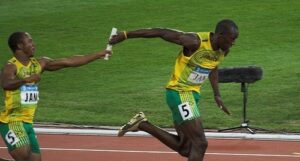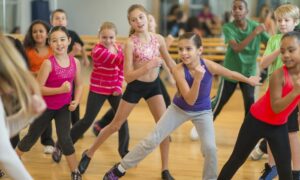Back to: Physical Health Education Primary 6
Welcome to today’s class!!
We are thrilled to have you in our class!!
In today’s Physical Education Class class, we will be focusing on Revision
Revision
Relay Race

It is normal to find a team of four runners running equal distances, generally 100m and 400m each, while passing a baton to one another on a rolling start, in a Relay Race.
A relay race is an event where a team of four athletes run equal predetermined distances in a sprint race, each passing a rod-like object called the ‘baton’ to the next person to continue the race. The last runner in a relay is called the ‘anchor’.
There are also other types of relays – like sprint medley relays (where each runner runs progressively longer distances like 200m, 400m, 800 meters and so on), long distance relays (which have more than five legs) and cross-country relays.
The 4x100m relay is an event where a relay team of four members each run a distance of 100m in a single designated lane.
During each leg run, the athlete has to carry a baton and hand it over to the next team member.
The baton exchange has to happen within a 20m changeover box, located 10m before and 10m after the start of each leg, starting from the second relay runner.
A team can be disqualified if any member drops the baton during the handover or if the handover occurs outside the designated area. The runner finishing the race will generally be the fastest sprinter in a team.
The rules for the 4x400m relay are largely similar to the 4x100m relays.
The team members cover a distance of 400m each before passing on the baton to the next team member, within the same 20m designated changeover area.
However, there is one key difference. While the first member runs 400m in a single designated lane, the subsequent members of a team can interchange lanes starting from the back-straight halfway through the second leg.
In summary, 400m runners compete for the inside line, which is the shortest route to the finish line. In this race, four athletes run equal predetermined distances in a sprint race, each passing a rod-like object called the ‘baton’ to the next person to continue the race.
Hurdle Race

A sport is called an Hurdle race when it involves a horse race where the horses jump over obstacles called hurdles.
These are smaller than fences and are a minimum of three and a half feet high.
They are typically made of a series of panels made of brush and are flexible.
Hurdle races have a minimum of eight hurdles and a minimum distance of two miles (3 km) but can be longer. These longer races are known as stayers’ hurdles.
They tend to be run at a faster pace than steeplechases as the height of the fence is much lower. The best hurdlers have a low and efficient style of jumping, which means they do not lose much momentum when they jump.
Horses that go hurdling are often former flat racehorses. Horses that have been bred for Jumps racing may also compete in these races to give them jumping practice before they go into Chases.
Many years ago, hurdlers ran at and jumped over each hurdle (sometimes known as ‘burgles’), landing on both feet and checking their forward motion. Today, the dominant step patterns are the 3-step for high hurdles, 7-step for low hurdles, and 15-step for intermediate hurdles.
Hurdling is a higher form of obstacle racing, and is part of the sport of athletics. In hurdling events, barriers known as hurdles are set at precisely measured heights and distances. Each athlete must pass over the hurdles; passing under or intentionally knocking over hurdles will result in disqualification.
In summary, the standard sprint or short hurdle race is 110 meters for men and 100 meters for women. The standard number of steps to the first hurdle should be 8. The standard long hurdle race is 400 meters for both men and women.
High Jumps

As the name suggests, high jump requires athletes to jump the highest possible distance vertically without dislodging a horizontal bar placed at a certain height. Unlike pole vault though, athletes must do high jump without any support, requiring high levels of speed, explosive power and agility on their part to succeed.
One important thing to keep in mind is that athletes can use only one foot during takeoff. In simpler terms, the jumper can only have one foot planted on the ground while initiating the jump.
The field for a high jump contest consists of three parts.
The first is the runway or the take off area. It is generally a minimum of 15m in length and 16m in width.
The second is the upright, which comprises two vertical bars supporting a horizontal crossbar measuring 4m. The crossbar is height adjustable and is not fixed to the vertical frames. It is placed very delicately and can be dislodged by the slightest of touches.
The third, meanwhile, is the crash mat placed behind the upright to cushion the jumper’s fall. It is mostly a safety measure to prevent any sort of injuries.
A high jump starts with an athlete using the runway to make an approach to the upright. As long as they stay within the limits of the runway, the jumper is allowed to make their approach any way they see fit. They can run straight or take an angled approach or run fast or slow towards the upright.
Once a jumper is near the upright, they airlift vertically using one foot during the take off. The objective is to clear the crossbar placed at a certain height from the ground and land on the crash mat. If the athlete manages to land on the crash mat without dislodging the crossbar, the jump is considered legal.
If any part of the jumper’s body touches the crossbar during a jump, it is still considered a legitimate jump as long as the crossbar isn’t dislodged.
However, if the crossbar gets dislodged from the vertical frames or the athlete touches the vertical frames during a jump, the effort is considered as a failed jump.
Also, a high jumper’s shoe needs to meet certain specifications. They can have soles with a maximum thickness of 13mm and heels with a maximum thickness of 19mm.
In summary, High Jump is a Sport where athletes are required to jump the highest possible distance vertically without dislodging a horizontal bar placed at a certain height.
Locomotive And Non-Locomotive Movements

Before we look at locomotive and Non-locomotive, let’s understand what a movement is.
A movement is an act of change in the position or location of something.
Movement is the natural way of shifting the body from one place to another. Now try shifting yourself from where you are to another. That’s movement!
Some examples of movement are:
- Jogging
- Crawling
- Leaping
- Hopping
- Running
- Walking
On the other hand, Locomotive is the movement of the body from one place to another. The movement can be forward or backward movement.
Examples Of Locomotive Movement include:
- Hopping
- Jumping
- Skipping
- Sliding
- Crawling
- Walking
- Running
- Galloping
As for Non-locomotive movements, they are movements that do not involve traveling from one place to another. There are many examples of non-locomotor movements, which include:
- Bending
- Stretching
- Extending
- Turning
- Raising
- Twisting
- Rotating
- Swinging
- Lifting
- Shaking
- Wiggling
- Pulling
- Dodging
- Pushing
- Swaying
- Flexing
What is an example of a non-locomotor skill?
Examples of non-locomotor skills include:
- A child who stands in place and bends at the waist downward to touch their toes
- A child extending their arms upward as if they were trying to reach the sky
- A child bending their knee upward to march in place
- A child performing a push-up
In summary, movement is the natural way of shifting the body from one place to another.
Evaluation
Give five examples of Locomotive and Non-locomotive Movement
Reading Assignment
- A person who participates in High Jump is called what?
- Identify three steps used in High Jumps
Weekend Assignment
- Explain what Hurdle Race is
- Mention two things that are found in Hurdle Racing.
We hope you enjoyed today’s class. In our next class, we will be talking about Food And Nutrition.
Let us know your thoughts and questions in the comment section, and we will attend to them as fast as we can.
